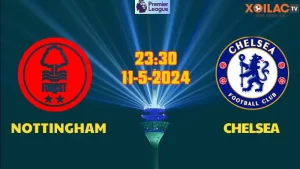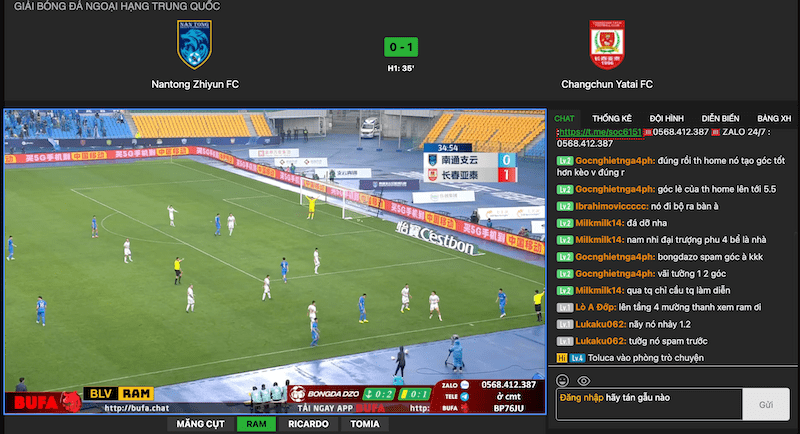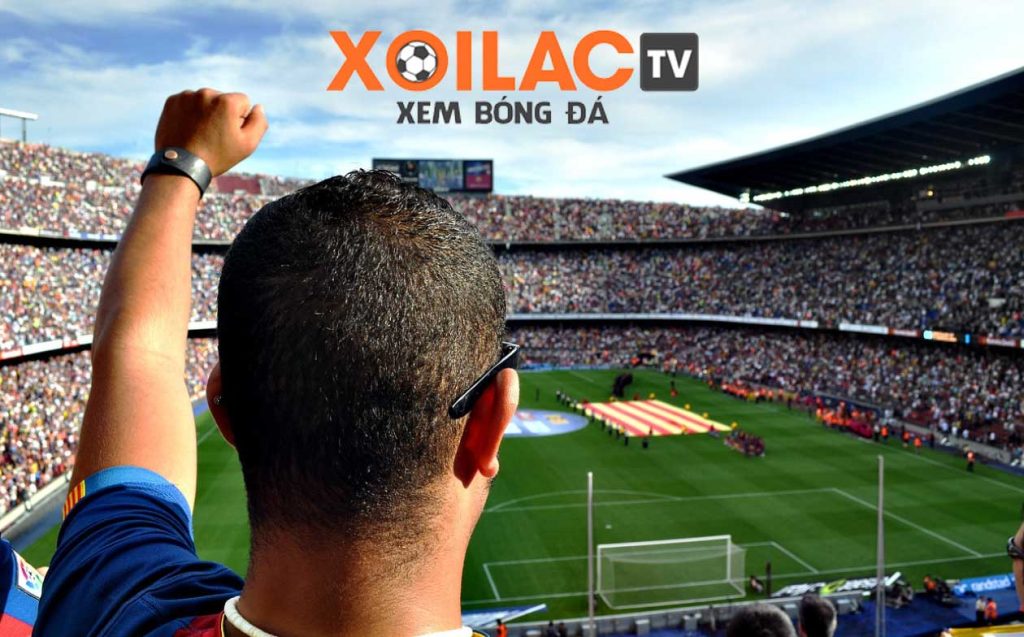

Xoilac TV tường thuật trực tiếp bóng đá hôm nay các trận đấu hấp dẫn với bình luận tiếng Việt chuyên nghiệp. Xôi Lạc TV đã trở thành biểu tượng của niềm đam mê không giới hạn với trái bóng tròn. XoilacTV cung cấp dịch vụ xem bóng đá trực tuyến với độ phân giải cao, hình ảnh mượt mà, sống động Full HD.
Xoilac là một trong những nền tảng trực tiếp bóng đá hàng đầu. XoilacTV đầy đủ các trận đấu từ khắp nơi trên thế giới như Ngoại Hạng Anh, La Liga, Ligue 1, Serie A, Bundesliga, Champion League, Europa League, World Cup 2026, Euro 2024, AFF Cup, SEA Games, V-League.
Xoilac TV đã trở thành một phần không thể thiếu trong cuộc sống của người hâm mộ bóng đá. Website còn mang lại cho người xem cái nhìn sâu sắc về từng trận đấu, thông qua các bình luận viên tiếng Việt giàu kinh nghiệm và am hiểu chuyên sâu về bóng đá thế giới.
Điểm nổi bật của bóng đá Xôi Lạc nằm ở số lượng trận đấu được phát sóng mỗi ngày lẫn ở chất lượng hình ảnh và âm thanh. Công nghệ phát sóng tiên tiến suốt 90 phút, giúp người xem có thể thưởng thức những trận cầu đỉnh cao với chất lượng cao nhất, không giật lag, mang lại cảm giác như đang ngồi trên khán đài.

Việc cung cấp một loạt các giải đấu từ khắp nơi trên thế giới, từ các giải lớn đến các giải nhỏ, chứng tỏ Xoilac là điểm đến lý tưởng cho bất kỳ ai muốn theo dõi và cảm nhận bóng đá một cách trọn vẹn nhất.
XoilacTV là địa chỉ quen thuộc của người hâm mộ bóng đá khi muốn theo dõi các giải đấu lớn ở châu Âu. Từ Premier League, La Liga, Bundesliga, đến Serie A và Ligue 1, tất cả đều được phát sóng trực tiếp. Sự đa dạng của các giải đấu giúp người xem có thể chọn lựa theo dõi đội bóng yêu thích của mình mỗi tuần. Ngoài ra, UEFA Champions League và Europa League, hai giải đấu cấp câu lạc bộ lớn nhất châu Âu, cũng được Website Xoilac đưa vào lịch phát sóng, mang đến những trận đấu đỉnh cao và kịch tính nhất.

Không dừng lại ở các giải lớn, chúng tôi còn mở rộng tầm nhìn với các giải đấu nhỏ hơn ở châu Úc và châu Á. Điều này giúp người hâm mộ có cơ hội khám phá bóng đá ở các quốc gia có nền bóng đá phát triển như Australia, Nhật Bản, Hàn Quốc, và cả những giải đấu mới nổi ở Đông Nam Á. Sự đa dạng trong chọn lựa giúp kênh bóng đá Xoilac thu hút được một lượng lớn người xem, từ những người hâm mộ bóng đá châu Âu đến những người yêu thích bóng đá khu vực và muốn theo dõi sự phát triển của bóng đá nội địa.
Ngoài bóng đá sân cỏ, Xoi Lac TV còn mang đến cho người xem những giải đấu Futsal và bóng đá bãi biển. Điều này thể hiện sự quan tâm và đầu tư của Xoilac đối với các hình thức bóng đá đa dạng, từ chuyên nghiệp đến phong trào, từ sân cỏ tự nhiên đến sân cỏ nhân tạo. Việc cung cấp các trận đấu Futsal và bóng đá bãi biển giúp người hâm mộ có cơ hội tiếp cận với những trận đấu đặc sắc, thú vị mà không phải lúc nào cũng dễ dàng tìm thấy trên các nền tảng khác.
Xoilac mang lại cho người hâm mộ không chỉ là cơ hội để theo dõi những trận đấu hấp dẫn mà còn cung cấp một loạt các lợi ích đáng kể, làm cho trải nghiệm xem tructiepbongda trở nên phong phú và đầy đặn hơn.
Một trong những yếu tố quan trọng nhất khi xem bóng đá trực tuyến là chất lượng hình ảnh và âm thanh. Chúng tôi cam kết mang lại chất lượng trực tiếp tốt nhất cho người xem. Sử dụng công nghệ phát sóng tiên tiến, trang web này đảm bảo hình ảnh sắc nét và âm thanh sống động, giúp người xem có cảm giác như đang ngồi trên khán đài. Điều này cực kỳ quan trọng trong những trận đấu căng thẳng, khi mỗi khoảnh khắc, mỗi pha bóng đều có thể quyết định kết quả của trận đấu.

Ngoài chất lượng trực tiếp, Xoi Lac TV còn mang đến lợi ích với dịch vụ bình luận tiếng Việt miễn phí. Điều này giúp người xem Việt Nam dễ dàng theo dõi và hiểu rõ hơn về diễn biến trận đấu. Đội ngũ bình luận viên giàu kinh nghiệm và am hiểu sâu sắc về bóng đá mang lại cái nhìn chuyên môn cao, đồng thời tạo ra không khí sôi động, hấp dẫn cho mỗi trận đấu. Sự kết hợp giữa chất lượng hình ảnh cao và bình luận tiếng Việt chất lượng giúp chúng tôi trở thành lựa chọn hàng đầu cho người hâm mộ bóng đá tại Việt Nam.
Xôi Lạc TV được thiết kế để đảm bảo sự tiện lợi và dễ dàng cho mọi người hâm mộ. Với một giao diện thân thiện và dễ sử dụng, người xem có thể dễ dàng tìm kiếm và theo dõi trận đấu mình yêu thích.
Để bắt đầu, người dùng chỉ cần một thiết bị kết nối Internet như điện thoại thông minh, máy tính bảng, laptop, hoặc thậm chí là Smart TV. Sau đó, hãy truy cập vào trang web chính thức của bóng đá Xoilac. Không cần phải đăng ký hay đăng nhập, tất cả những gì bạn cần làm là chọn trận đấu bạn muốn xem và bắt đầu thưởng thức. Điều này làm cho việc theo dõi bóng đá trở nên nhanh chóng và thuận tiện, không phụ thuộc vào thời gian hay địa điểm.
Ngoài ra, nơi đây còn có thể theo dõi qua điện thoại qua các trình duyệt, cho phép người hâm mộ xem bóng đá mọi lúc, mọi nơi chỉ với một cú chạm. Các phiên bản di động được tối ưu hóa để mang lại trải nghiệm xem tốt nhất, với tất cả tính năng của website phiên bản máy tính nhưng được thiết kế lại cho màn hình nhỏ hơn.
Việc truy cập và sử dụng website Xoilac đơn giản, thuận tiện, cung cấp cho người hâm mộ cách thức tốt nhất để theo dõi bóng đá trực tuyến. Với chất lượng trực tiếp cao và dịch vụ bình luận tiếng Việt miễn phí, nền tảng này chính là lựa chọn lý tưởng cho mọi người yêu bóng đá.

Mục tiêu xa hơn của Xoilac TV là trở thành nguồn thông tin bóng đá số một tại Việt Nam, nơi mà mọi người có thể truy cập để cập nhật tin tức, xem trận đấu, và tham gia cộng đồng người hâm mộ. Phát triển từ một website xem bóng đá trực tiếp, Xoilac TV mong muốn mở rộng dịch vụ của mình, bao gồm việc cung cấp phân tích chuyên sâu, tin tức mới nhất và các chương trình nội dung đặc sắc liên quan đến bóng đá.
Trong quá trình phát triển, web bóng đá Xoilac luôn chú trọng đầu tư vào công nghệ để nâng cao chất lượng dịch vụ. Từ việc cải thiện đường truyền để đảm bảo trận đấu được phát sóng mượt mà, cho đến việc phát triển ứng dụng di động giúp người xem dễ dàng truy cập mọi lúc, mọi nơi. Xôi Lạc mong muốn nâng cao trải nghiệm, tạo dựng một cộng đồng người hâm mộ bóng đá vững mạnh.
Xoilac không những là nơi để xem bóng đá trực tuyến, mà còn là nguồn thông tin đáng tin cậy để nhận định kèo nhà cái. Người dùng có thể dễ dàng tiếp cận các tip kèo từ hai nguồn chính: trực tiếp trên website và thông qua các nhóm cộng đồng của Xoilac.
Các nhóm cộng đồng của Xoilac, được tạo ra trên các nền tảng mạng xã hội như Facebook, Zalo, hoặc Telegram, là nơi mà người hâm mộ có thể thảo luận, chia sẻ nhận định và nhận tip kèo từ các chuyên gia và những người có kinh nghiệm. Tham gia vào cộng đồng này, người dùng sẽ nhận được thông tin kèo lẫn có cơ hội giao lưu, học hỏi từ những người khác, từ đó nâng cao kiến thức và kỹ năng cá cược của bản thân.
Xôi Lạc TV tự hào về tỷ lệ tip kèo chuẩn xác cao, nhờ đội ngũ phân tích viên chuyên nghiệp và việc sử dụng dữ liệu bóng đá chính xác. Các tip kèo được nghiên cứu kỹ lưỡng, phân tích từ nhiều góc độ như phong độ đội bóng, lịch sử đối đầu, tình hình lực lượng… nhằm mang lại cái nhìn toàn diện nhất cho người dùng trước khi đưa ra quyết định cá cược.
Điểm mạnh của Xoilac là chất lượng trực tiếp bóng đá vượt trội. Trong khi nhiều nền tảng khác thường xuyên gặp vấn đề về độ trễ hoặc giật lag. Chúng tôi cung cấp trải nghiệm xem mượt mà với chất lượng hình ảnh HD, đảm bảo người xem không bỏ lỡ bất kỳ khoảnh khắc nào của trận đấu.
Ngoài ra, dịch vụ bình luận tiếng Việt miễn phí là một điểm cộng lớn cho Xoilac TV. Điều này giúp người hâm mộ Việt Nam dễ dàng theo dõi và hiểu rõ các tình tiết trận đấu mà không cần phải đối mặt với rào cản ngôn ngữ, một lợi thế mà không phải nền tảng miễn phí nào cũng có thể cung cấp.
Cuối cùng, Xoilac TV cũng dẫn đầu về đa dạng nội dung. Địa chỉ này không giới hạn ở việc phát sóng các trận đấu, Xoilac TV còn cung cấp tin tức bóng đá cập nhật, phân tích trước trận và nhận định kèo, mang lại cho người dùng một góc nhìn toàn diện về thế giới bóng đá.
So sánh với các nền tảng khác, Xôi Lạc TV vượt trội nhờ vào sự kết hợp giữa chất lượng dịch vụ và độ phong phú của nội dung, làm cho nó trở thành sự lựa chọn số một cho người hâm mộ bóng đá.
Một số thương hiệu website trực tiếp bóng đá khác mà bạn có thể tham khảo là: 90Phut TV, Cakhia TV, Mitom TV, Caheo TV, Vaoroi TV, Vebo TV, Chaolua TV, Socolive TV, Luongson TV, Cola TV, Xoivotv, Tiengruoi TV, Demnay TV.

Xôi Lạc TV cung cấp một công cụ tìm kiếm rất tốt để bạn có thể dễ dàng tìm kiếm nội dung mà bản thân mong muốn. Bạn có thể nhập từ khóa tìm kiếm, tên một giải đấu, một cầu thủ hoặc thể loại tương tự để hiển thị kết quả phù hợp. Bên cạnh đó, trang web cũng cung cấp các danh mục và thẻ liên quan để bạn có thể dễ dàng xem qua các nội dung khác nhau.
Xoilac cho phép người dùng chia sẻ nội dung giải trí mà họ yêu thích từ trang web lên mạng xã hội. Người xem có thể sử dụng tính năng chia sẻ được tích hợp sẵn hoặc sao chép đường link rồi chia sẻ nó trực tiếp trên các nền tảng mạng xã hội cực kỳ dễ dàng.
Không, chúng tôi là một trang web phát sóng bóng đá miễn phí. Bạn không cần trả bất kỳ khoản phí nào để xem trực tiếp các trận đấu như K+, FPT Play, hay VTV.
Hiện tại, trang web không áp dụng giới hạn địa chỉ IP. Bạn có thể truy cập và xem trực tiếp các trận đấu từ bất kỳ địa điểm nào.
Xôi Lạc TV cung cấp video highlight để bạn có thể xem lại các diễn biến chính của các trận đấu đã kết thúc. Video highlight có chất lượng cao và giúp bạn không bỏ lỡ những khoảnh khắc quan trọng trong trận đấu.

Xoilac TV chính là câu trả lời cho những tìm kiếm đó, là điểm đến không thể bỏ qua của người hâm mô môn “thể thao Vua”. Xôi Lạc TV cung cấp link xem trực tiếp bóng đá hôm nay đa dạng và chất lượng cao. Truy cập ngay để tận hưởng trọn vẹn 90 phút những trận cầu hấp dẫn nhất.